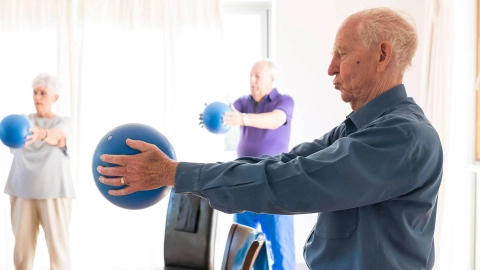Care Prevention and health in care facilities
Health promotion and prevention are also important in care facilities. The aim is to improve or maintain the care recipients’ health, but also to encourage their independence and mobility.
At a glance
- Care funds are responsible for helping care facilities with health promotion and prevention.
- The aim is to improve or maintain the care recipients’ health, prevent further deterioration, and to encourage their independence and mobility.
- Topics include diet, exercise, mental health, emotional well-being, and preventing violence.

Health promotion in residential care facilities
People want their life to be not only long but also as self-determined and healthy as possible, and this also applies to residents in care facilities. Because even when someone is already in need of care, there are usually ways of improving their health, counteracting any deterioration, and preventing further impairments.
In 2015 health promotion and prevention in residential and semi-residential care facilities were given a legal anchor via the Prevention Act. This specifically makes the care funds responsible for promoting good health, preventive measures and identifying health problems at an early stage.
In the “Guide to Prevention in Residential Care Facilities in Compliance with § 5 SGB XI”, the National Association of Statutory Health Insurance Funds (GKV-Spitzenverband) summarizes the content and quality requirements that the prevention measures should satisfy.
Why is health promotion in care facilities important?
The number of care recipients in Germany is steadily rising: in late 2017 there were around 3.4 million people in need of care living in Germany. By the year 2050 experts estimate this figure will increase to around 5.9 million. The number of residents in residential or semi-residential care facilities is likely to increase, too.
Which measures are promoted in care facilities?
The Prevention Act deals with health in its broadest sense. So measures can be taken that are not only aimed directly at illnesses or impairments. Measures that serve the care recipient’s general well-being are also included. These are intended to help promote and maintain the independence of care home residents.
Measures that improve the care facility’s own capabilities are funded. These may include, for example, developing structures that benefit health, like new working methods, or providing the framework for non-violent care that does not require measures such as confinement and restraint.
Measures that improve the health of individual care recipients are also funded. This includes measures such as:
- healthy eating
- physical activity and exercise
- mental health
- emotional well-being
Healthy eating
Pleasant, varied, adequate food and drink can prevent health problems and improve emotional well-being. For example, residents’ preferences can be included in menus where possible. Swallowing and chewing problems, which are often a reason for a poor diet, can also be looked at.
Physical activity and exercise
Regular exercise protects against falls, but also improves well-being and reduces the risk of chronic illness. Exercises may involve climbing stairs, walking and balancing, through to broader exercise programs, depending on what the care recipient is capable of doing. Every small step is important and promotes good health.
Mental health
Tasks and exercises that train the memory and understanding help the residents’ mental health. Physical activities contribute to it, too.
Emotional well-being
Activities that improve residents’ self-esteem, encourage their social contacts, and support them in their personal interests enhances general well-being. This counteracts depression and addiction problems.
How is health promotion organized in my facility?
For measures to have a positive effect it is important that they suit the particular characteristics of the facility concerned, its residents and the nursing staff. With this in mind, the initial situation and the needs are identified, and the measures are then based on them.
The care funds help care facilities to plan and implement these measures. The health promotion is more effective if everyone concerned is involved in planning and evaluating the measures: care recipients, the home’s board, loved ones, and legal guardians.
If you or your loved ones have any questions about health promotion in your facility, you should talk to a member of the nursing staff or the facility’s manager.
Further information
There is more information and examples of health promotion in care facilities on the German-language website about healthy living environments run by the Association of Substitute Health Insurance Funds (Verband der Ersatzkassen, vdek).
- Bundesministerium für Gesundheit. Prävention in der Pflege. Aufgerufen am 08.02.2021.
- Bundesministerium für Gesundheit. Präventionsgesetz. Aufgerufen am 25.05.2020.
- Deutsche Gesellschaft für Ernährung. 14. DGE-Ernährungsbericht. Vorveröffentlichung Kapitel 2. 10.2019.
- GKV-Spitzenverband. Prävention in der stationären Pflege. Aufgerufen am 26.05.2020.
- GKV-Bündnis (GKV-Spitzenverband). Gesundheitsförderung in Pflegeeinrichtungen. Aufgerufen am 5.3.2020.
- Rütten A, Pfeifer K (Hrsg.). Nationale Empfehlungen für Bewegung und Bewegungsförderung. FAU Erlangen-Nürnberg 2016.
- Statista. Sozialsysteme - Anzahl der Pflegebedürftigen und über 80-Jährigen in Deutschland bis 2060. Aufgerufen am 25.05.2020.
- Statistisches Bundesamt (Destatis). 818 300 Pflegebedürftige lebten Ende 2017 in vollstationären Pflegeheimen. Aufgerufen am 25.05.2020.
Reviewed by the German Society for Social Medicine and Prevention (Deutsche Gesellschaft für Sozialmedizin und Prävention e.V.) (DGSMP).
As at:



